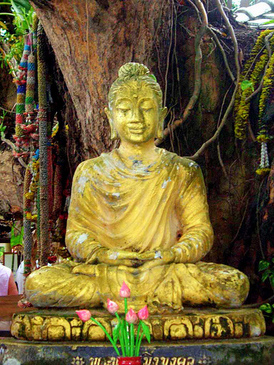 Kunaram Temple, Koh Samui, Thailand/clayirving The New York Times calls A.Word.A.Day edited by Anu Garg “The most welcomed, most enduring piece of daily mass e-mail in cyberspace.” I subscribe. It is free and at the bottom of the email is “A Thought for Today,” a mini-treasure of unsolicited wisdom.
One day this week Lao-Tzu, philosopher (6th century BCE) told me: “Every human being's essential nature is perfect and faultless, but after years of immersion in the world we easily forget our roots and take on a counterfeit nature.” Lao-Tsu’s lofty thought dovetailed neatly with the answer I gave my friend at coffee one morning when she asked me what I was getting out of practicing meditation.
The night before we met for coffee, we were part of a midweek meditation circle that meets in the chapel at the Unitarian Universalist church. Like everyone else there, I was asked to talk about my meditation practice. I think I sounded serious about it as compared to the stop and start nature of other reported practices. Not that I compare. I actually felt somewhat apologetic about sitting almost everyday, about wanting to secure a meditation instructor, and that mudras makes me feel peaceful and proper.
For me, a mudra is a reminder to be aware whether moving and sitting among others or being completely solitary. As I have learned it, mudras are bodily postures or symbolic gestures that help to bring about a connection between the sitter and the Buddha as seen in pictures or statues doing a practice.
A meaningful mudra in my practice is the Dhyani Mudra, a gesture with the back of the right hand resting on the palm of the other so the tips of the thumbs lightly touch one another as the hands rest in the lap. The right hand, resting on top, symbolizes an enlightened state; the other hand, resting below, the world of appearance. I can see in it Lao-Tsu’s vision of both parts of the self, “the perfect faultless essential nature” and the “counterfeit nature”.
All this Lao-Tsu stuff is hard to paraphrase, so at the table over coffee, I diagrammed for my friend who has more of an intention to meditate than a practice, how it looked to me that meditation worked. In my journal I drew a blacked-in crescent moon that I labeled constricted or small sense of self and then I completed the moon-shape, leaving this part of the circle empty to represent the silent, spacious, luminous self. This is the “perfect and faultless” part of myself that becomes accessible through sitting still and letting be.
Lao-Tsu might say the sloppy blacked-in crescent was the “counterfeit nature” that I constructed to serve me in the world of appearance. And I would add that the blacked in part is all I thought I was and the fixing I paid for in therapy was either to erase the mess or improve upon it. In short, make me different than I am.
Meditating lets me experience myself as awareness; sometimes a thought flits across that awareness, sometimes a familiar dreadful pain or panic lands with a thud and threatens to upset the settled self, but breathing into it, welcoming it into the silence loosens my identification with those blacked in parts. I don’t want to turn against the constricted me represented by the blacked-in crescent. Acceptance of this imperfect self will let me continue to be imperfect, but to accept my small self with more equanimity.
This may sound very self-involved, but I have learned that meditation practice intends to improve the welfare of all beings as it teaches those who sit to be kinder, listen better, be more generous and cause less harm.
These lines from poet May Sarton’s poem “Now I Become Myself” describe what it feels like to me to meditate.
“Now there is time and Time is young.
O, in this single hour I live
All of myself and do not move.”
Truthfully, I am not yet up to sitting one hour without a break and my “counterfeit nature” sometimes takes up more than a little space in the full circle of my being.
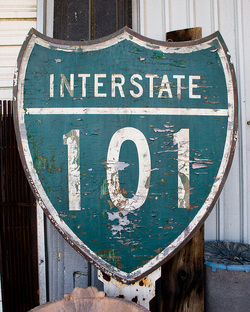 No Interstate I've Seen / Orin Zebest Buddhist meditation is a way to reveal the self to the self and to quiet the mind so that we can get out of our own way for the benefit of all beings. With practice, I am less at the mercy of my amygdala* when I am irritated, slighted, overlooked, disregarded or kept waiting, all of which can happen when visiting family.
As I drove north on the 101 after visiting my son and granddaughter, reality forced me once more to reconsider of my familiar family stories and the way I imagine my three sons think and feel. Many of my stories about the mother I was are not corroborated by my sons. They seem to remember differently or not at all. Furthermore, everyone has changed, outgrowing the stories; everyone’s life has become more complicated.
I was especially aware of the paucity of useful information in stories about my youngest son after spending the week with him and my four-year-old granddaughter. He is a do-it-alone dad now. Out of respect for his privacy, I have not talked about the accidental death of my daughter-in-law last November. Of course, my son and Miss E are never far from my thoughts, but I discovered that compared to the reality of their routine, the stories I tell myself about them are out of touch with who each of them is as they form this new life without a wife and a mother.
My visit last week did not, as I had hoped, make life easier for my son. Thus when I left Friday morning before either he or Miss E awoke, I was grateful for the practices of equanimity and loving-kindness that helped me handle my sadness throughout my visit. I knew Friday would be less complicated for him, and Miss E would be less distracted and more comfortable in their routine.
I do not feel less loved because my leaving was so welcome. Of course, I continue to love this son unconditionally, even though the depth of his grief, the heat of his anger, and the heaviness of being charged with responsibility for his child’s life have eclipsed the easy-going thoughtful youngest son of my stories.
As I said, practicing equanimity was a big part of my visit. Gil Fronsdal of the Insight Meditation Center in Redwood City, explains that the most common Pali word translated as equanimity is upekkha, meaning to look over. It refers to the equanimity that arises from the power of observation, the ability to see without being caught by what we see. This does not mean that I was unaffected by the confusion and disruption that seemed to characterize my visit.
He says, “Upekkha can also refer to the ease that comes from seeing a bigger picture. Colloquially, in India the word was sometimes used to mean ‘to see with patience.’ This form of equanimity is sometimes compared to grandmotherly love. The grandmother clearly loves her grandchildren but, thanks to her experience with her own children, is less likely to be caught up in the drama of her grandchildren’s lives.”
Once back in San Francisco, I could call my son and compliment him on his equanimity in the face of four-year-old tantrums and meltdowns. I know parenting is difficult even under the best of circumstances.
When I was in the park playing dinosaurs with Miss E, she decreed that I would eat a pine cone, and when I demurred, she hurled invectives at me and said I could never visit her house again. That moment reminded me of how in my own long-ago upbringing, my childish anger would have elicited reciprocal rage and there would have been an emotional price to pay. I am grateful that all of us who love Miss E allow her the space to express her feelings, and when she does have to take a time-out, I notice that my son tells time faster than the clock ticks it off.
As well as relying on equanimity, I often turned to metta, a term meaning loving-kindness, friendliness, goodwill, and benevolence. It is a strong wish for the welfare and happiness of others. Through metta one refuses to be offensive and renounces bitterness, resentment and animosity of every kind.
And as I waited for my son to come back from an errand he assured me would take five minutes, but which in fact took 45, I reminded myself as I did a walking meditation on the quiet block where he lives that metta is the protective and immensely patient attitude of a mother who forbears all difficulties for the sake of her child and protects him despite misbehavior…or tardiness.
May you be happy.
May you be free from stress and pain.
May you be free from animosity, free from trouble.
May you be free from oppression.
May you look after yourself with ease.
And I alternated with “May I be happy” and interspersed, “May all beings be happy.”
* “Amygdala hijack” is a term coined by David Goleman in his 1996 book Emotional Intelligence: Why it Can Matter More Than IQ. The term describes immediate and overwhelming emotional responses more extreme than the actual emotional threat warrants.
 Fourth of July Fireworks/crazyk8e1 Celebrating the 4th of July is my excuse to link freedom to the practice of meditation, part of the Bodhisattva path. Getting free is not just an event in the past to be celebrated, nor is it only a future goal. It is not an escape from a situation, or “from” anything at all, but is within right now. Which is not to say that freeing up is easy although, paradoxically, it isn’t hard. In fact it isn’t anything. It’s meditation: sitting still in one’s own spacious skies. Looked at through the lens of my new Buddhist practice, familiar quotes take on a new or differently nuanced meaning for me. “ Freedom's just another word for nothing left to lose.” That is Janis Joplin belting it out in “Me and Bobby McGee” her husky cry of pain is for how we suffer until finally we realize there really is “nothing left to lose.” This says to me that personal pain (Buddha calls it suffering) is the doorway to awakening through which we must go. “Freedom is what you do with what’s been done to you.” Jean Paul Sartre being existential. Sartre accepts that damage has been done, or will be done. It is inevitable. That being so, what next? “I know but one freedom and that is the freedom of the mind.” Antoine de Saint-Exupery wrote The Little Prince, which has at its heart the notion that an innocent, personal perspective on the universe proves to be more serious than a jaded second-hand perspective. Saint-Exupery places problems where they mostly are, in our minds and perspectives. Shift perspective, things change, we change. The Buddha calls serious commitment to a perspective that leads to awakening, “intention.” “Freedom doesn’t mean the absence of restrictions. It means possessing unshakable conviction in your choices in the face of an obstacle.” – Mahatma Gandhi, who also said, “Freedom is not worth having if it does not include the freedom to make mistakes.” Gandhi knows that freedom and discipline are not opposites. The act of sitting still and being present to one’s experiences can be unpleasant or pleasant. Either way, sitting still is a discipline. “Free at last, free at last, thank God Almighty, We are free at last.” -Martin Luther King, Jr. speaking the words of a Negro Spiritual in his “I Have a Dream” speech. Dr. King reminds me that we are all in this together and no matter how private my meditative practice, its purpose is more than personal freedom. It is about everyone’s well being. As for freedom for those on a spiritual path, I like what Jackie Vecchio says in “Four Simple Steps to Freedom.” I recommend her blog at tiny Buddha. Here’s a summary of those four simple steps. 1. Don’t take anything personally.
2. Don’t be a victim.
3. Be gentle, kind, and compassionate with yourself.
4. Practice forgiveness. She says, “Nothing anybody says or does to you has anything to do with you.” People’s opinions are solely the product of their own lives and realities. “Hear what they say, accept that it is a reflection of their world and poof. See the thought disappear.” I’m not very good at this yet. As for Jackie’s second point about not getting caught in the victim trap, I check with my body and as a result generally downgrade disaster to unpleasantness, unless it is truly a disaster and in that case the body will say so. Here is where equanimity is useful. Allowing myself to experience something or someone as unpleasant is sometimes enough to forestall the stories that make unpleasant a more serious source of pain and turn me into a victim. The step to freedom Jackie lists as third is becoming kind to oneself. That was my first step and it was not easy for me. My inner guides tended to yell and say nasty things. They called me names that my four-year-old granddaughter delights in telling me are on the “no-say” list: words like “stupid,” “dumb,” “ugly,” “mean,” and “lazy.” Very early in my Budddhist practice, even before I sat in brief pockets of silence, I listened to Tara Brach’s gentle, modulated voice leading podcasters in guided meditations. Her kind reminders to call ourselves back from thought was a far cry from my own heavy handed corrections to my mind when it wandered. I liked Tara’s voice and wanted to talk to myself like that. Jackie suggests shifting hurtful thoughts to ones that are more loving and kind, replacing each negative with a positive. “Eventually you will start believing them. Doing so allows you to have the freedom to just be you,” she says. I had always considered that “being me” was the problem. As for the last of Jackie’s steps: Forgiveness. Forgiveness is letting go of the hope that the past can be changed. Forgiveness isn’t about saying that whatever happened was okay, right, or just, but about letting it go. Forgiving releases the power the past holds. Of course, things cannot be different and wishing for a different outcome is useless, painful and power-sapping. Because the present is the only time that exists, to forgive is to be in it. It is the only place we have the power to live free and happy. And so, as the 4th of July approaches and the country commemorates independence that began in revolution, I think of the centering that’s required to revolve and to evolve. For me this means sitting still for “spacious skies” of my own. Feeling my own ample waves of grief. Then I can make the world a better place—an act from love rooted in compassion.
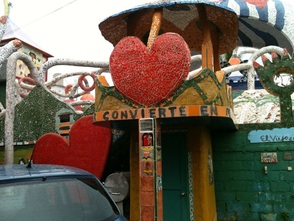 Fuster transforms the community/AlisonR Pictures I took show some of what I saw. There was so much to see and many ways to be impressed by this country of contradictions.
Gaudy Gaudi – That’s my nickname for the mosaics decorating 80 houses in the barrio of Jaimanitas on the outskirts of Havana. Created by renowned Cuban artist José Fuster using tiles and bits of discarded stones and glass, the run down community is transformed into color and dreaminess.
Peeling paint – Over the years, salt air has stripped away paint and now different layers of color give each building its own look. Paint is hard to come by because of the U.S. blockade (bloqueo in Spanish)
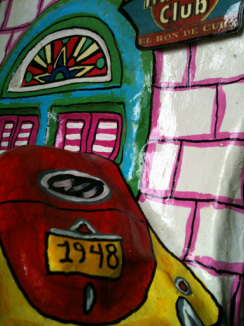 Car replica creation/Alison R Colored License plates – Indulge me in the following explanation culled from an on-line publication by the Filipino Global Community written in February of 2010. "Authorities keep tabs on people and their vehicles through color-coded license plates, a system copied from the former Soviet Union. “The government owns most cars. They have blue plates with letters and numbers that indicate when and where the vehicle can operate and whether the driver can use it for personal as well as professional reasons. Executives at government-run firms - who get caramel-colored plates — have more leeway. "In Cuba, the first letter in the license plate indicates which of 14 provinces the car hails from, such as "H" for Havana. The letter "K" means the car is privately owned -- either by a person or by a foreign firm. Military vehicles have mint-green, rear-only plates; olive-green plates are for vehicles issued by the Ministry of the Interior, including Fidel Castro's fleet of armored Mercedes 280s, which were built between 1982 and 1984. Black plates are for foreign diplomats, who don't have to adhere to traffic laws. White-plated vehicles are driven by Cuban government ministers or heads of state. The last three digits on diplomatic plates often denote the professional rank of the driver. So, if you're stuck behind a gray Mercedes with black license plate 179-004, that means the fourth most-important officer from the Russian embassy is likely behind the wheel. Rental cars get maroon plates. Foreign journalists, religious leaders and Cubans working for overseas firms have neon-orange ones. Red "provisional" plates allow vehicles to circulate while authorities sort out just what color tag they should get. Most of the half-century-old American roadsters that create a moving museum along the island's potholed streets have yellow license plates, meaning they are vehicles owned by ordinary Cubans. "Detroit's chrome-and-tail-fin era cars are still prominent on the roads because Cubans with non-VIP jobs can buy and sell only cars manufactured before the Castros took power in 1959. Buying newer vehicles requires government permission, including justifying how you can afford a car when the communist state controls well over 90 percent of the economy and pays employees an average of about $20 a month.” philSTAR.com
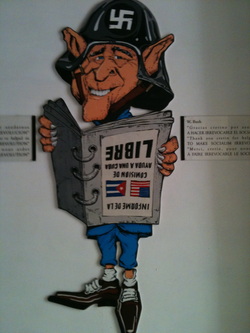 Cartoon in Palace of the Revolution/Alison R The American Bloqueo – Also referred to as an embargo, it is the reason Cuba doesn’t have McDonalds or Walmarts as well as paint.
Propaganda – With few products to sell, billboard space and walls sell the revolution. My favorite anti-imperialist blast seen in Havana on the way to the airport translates, “Blockade: the longest lasting genocide in history.” Of course, Ernesto Che Guevara’s face is for sale on every visible surface from tea cups to bibs, and one sees the less familiar face of Camilo Cienfuegos, a revolutionary who fought along with Fidel. Officially, America is a villain; personally, I felt cared for.
Tour Buses – Big, made in China or Russia and owned by the state. Perfumed, air conditioned and faithful to their schedules. Drivers politely assist passengers at each stop.
Alcohol – Pina Colada –Blend Havana rum, cream of coconut and pineapple juice with crushed ice until smooth. Garnish with a pineapple slice and a maraschino cherry. As for a Mojito, take a generous sprinkling of sugar and add the juice of half a lime and some scrunched up mint leaves, mix it up, pour on a stiff measure of light dry rum and add soda water and ice... and serve with a straw. Both drinks available almost anywhere, even bus stops on the way to and from hotels.
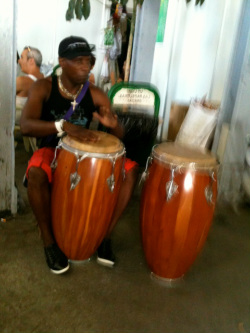 Musician in Havana market/AlisonR Music – Everywhere, all the time. And every duo, trio, quartet or drummer peddled a CD. I couldn’t fault the ways Cubans found to make money, whether making music in state-owned restaurants, markets or by wheeling a dog in sun-glasses, sucking a pacifier into a plaza on a bicycle for tourist photos.
Food – not very good. Because we were 74, plus guides and drivers, not many restaurants could accommodate a group our size. Restaurants are mostly state-owned and while the service is kind, the food is not especially good even if you like rice and beans, called Christians and Moors because of the colors of the rice and the beans. For smaller groups dining out, private restaurants called paladares offer food in people’s homes. I ate pizza one night at 9:30 p.m. in a small outdoor restaurant three blocks from the Copacabana Hotel where we stayed the first three nights of our visit. The cook said no fresh tomatoes that night. It was okay though.
Cuba is beautiful, complicated, paradoxical, socialist, and tourist-friendly. Go there when you can, but go with a small group of people you know well enough to process what you see, hear and experience.
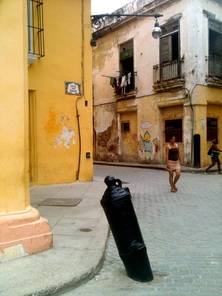 A corner in Old Havana / AlisonR Vayas donde vayas, alli estaras.* Or so they might say in Cuba. In airports, on tour buses, in hotels, restaurants, in Havana, Matanzas, Varadero, Cienfuegos, Trinidad and back at the Copacabana in Havana, I was much the same human being I had been in San Francisco except for swollen feet and ankles. In past travel, I had relied on avoidance-strategies to cope with the strange or disorienting. But this time, bolstered by 55 Tara Brach meditation podcasts, and a budding meditation practice, I was present; I was really there for the pleasant and unpleasant. I was confused and anxious as we milled around the American Airlines Charter Flight counter at the Miami-Dade airport eager to enter Cuba and whatever awaited us just 90 miles from Key West. The trip, organized by Global Exchange, was to encourage cultural sharing through choral music. We were a group of 74—the UC Alumni Chorus, Unitarian Universalist choir, 18 or so young Berkeley singers and a few like me who came along for the ride. I could go to rehearsals and performances, encourage the singers, be an appreciative audience or I could stay in an air-conditioned hotel room and read “The Tiger’s Wife” by Tea Obreht or listen to any of my Tara Brach talks. There I was, present with my “All About Me” syndrome as I faced Cuban customs in Havana. Would I be the one among us ordered to open her suitcases? Would I have to explain my reading material? My large assorted collection of generic pills? Would they look askance at a coat lugged into extreme heat and humidity? Would a Cuban TSA tear out the lining in search of contraband? What about the stack of unworn underwear I planned to leave in Cuba as a sign of my goodwill to the people? Could anything be judged nefarious? If I am questioned, will it hold up the tour buses that wait outside Jose Marti Airport? In fact, one of our group did delay our departure from the airport because in the spirit of goodwill she brought bottles of expired veterinarian medicines into the country, and airport officials were not happy. Finally, after an hour of sitting in the buses, their motors running, the air conditioning spewing perfumed air, we saw a tour guide go back into the terminal to bring Spanish into her side of the discussion to see if that might help her. The rest of us proceeded to the restaurant. Later, when the two joined us, we clapped. From goat to hero in time for lunch. Because we got back to San Francisco late Friday night and I slept through most of Saturday, this brief account written Sunday can’t explore all I felt, saw and did those 13 days. But let me cover a few experiences, some of which required mindfulness to remain equanimous if travel were not to devolve into travail. For one, toilet paper is a luxury, not to be expected. Sometimes a lady would sit at the opening of the bano and sell pads of toilet paper for a small amount.** One soon learned to be self-sufficient. In fact my roll of Cuban toilet paper continued to serve me even after we had landed back in Miami at the end of the trip. Irony of ironies, my particular airport bathroom stall lacked toilet paper. And with left-over equanimity, I tittered about it. Present to the dilemma of unpotable local water supplies and the specter of my plastic bottles cluttering the land fills, I developed an emotional attachment to large plastic botellas de agua from which I poured into multiple little botellas for easier transport as I strolled about the various courtyards or hung out in small stifling rooms listening to Arturo or Eliseo, our guides, translate lectures about state-sponsored music education. Did I always care? Was I always hot? Often thirsty? No, yes, yes. In other posts I want to tell you more about experiencing Cuba as a member of a large tour group. These experiences are too piled up to unpack now and share from a place of response rather than reaction. For now, let me say that old cars do exist in Cuba, but so do newer cars – Fiats, Kia, Hyundai, and I even saw a Prius and a Toyota Corolla or two. The state does own almost everything, but that too is changing. At about 1 a.m., finally home after a long day in the Miami-Dade airport, a five plus hour flight, and a three-hour time difference, I tried the key to the front door of my building. As the friends who brought me home drove away, I discovered the lock to the building had been changed while I was gone and the key didn’t work. And just then a third-floor neighbor pushed open the door so his darling dog, Cooper, could make his late night foray. Such luck. And so I was home, exhausted but still present with an overwhelming gratitude, or as we say en espanol, gratitud. * As spoken in English by actor Peter Weller in the 1984 film The Adventures of Buckaroo Bonzai Across the 8th Dimension: “Wherever you go, there you are.”
**About money. Tourists use CUCs, which is the convertible peso. We pronounced it “kooks.” Right now the exchange rate for $10 is 8.70 CUCs. (On November 8, 1994, the American dollar ceased to be accepted in Cuban retail outlets, leaving the convertible peso as the only currency accepted in many Cuban businesses, according to Wikipedia.)
 Chapel Window/Mike M I have great respect for all who sit through worship hour on Sundays at my Unitarian Universalist church, even the ministers on the chancel waiting to address the diverse, sometimes contentious congregation. I am sitting too, with an open journal in my lap and a pen in hand. I am not one to conceal the ear buds of my smart phone. I won’t listen to podcasts of dharma talks in service because I don’t want to miss Reiko at the organ, the choir, the bell chorus chiming out its melodies or the musicians we sometimes hire to play interesting or unfamiliar instruments. Because I am about to complain, you have every right to wonder why I don’t just stay home that one hour on Sunday. I’m there many other days of the week with commitments and committees. Of course, like others, I go to service with my own needs, preferences and mindsets. Right now my mind is set on compassion, with seeing through duality to the interconnection between all beings, which I believe is not only possible, but already actual. Do I hope for too much if I wish to be challenged to try to be kinder, to try to see someone else’s point of view, in short, to move beyond us and them to “the interdependent web of all existence of which we are a part?” For the rest of the week, I will be awash in rhetoric from the left and from the right, some subtle, some stupid, but always polarizing, always “us against them.” I am not keen to hear my ministers congratulate me for being on the right side of some social issue. If there is a right side, there is a wrong side. And because every issue has to be espoused or defended by someone, we now have those who hold wrong beliefs as opposed to right beliefs, and if we congratulate ourselves for being right, where does that leave those others? In a polarized society, those others will not be understood, at least not by us. We will be congratulating ourselves for being pro-choice or pro-recycling and composting. And while we call ourselves an embracing community, our arms are mostly open to those who think like us, vote like us, march where we march, occupy when we do, and support our values. Of course, we love strangers, at least in the abstract. And we love each other, though sometimes just as abstractly. Often we bring that “us vs. them” mentality, which is human nature, into our congregation. And this is where my dissatisfaction feels strongest with sermons that seem to reinforce the spirit of contentiousness rather than create wholeness or holiness. We do not need to agree but we do need to learn to respect and respond to each other with kindness. Then this response-ability can lead us into action. Most of us don’t need to have righteous indignation reinforced. We don’t need to be encouraged to ride our “hobby horses,” those favored social positions we believe in fervently, those truths we hold self-evident. In truth I often arrive at Sunday service feeling constricted, in pain, sorrow and fear, self-righteous and judgmental. What I want from the pulpit is not reassurance that my way is the right way but a reminder of my larger, kinder self. The late Forrest Church said: “Universalism is an exacting gospel. Taken seriously, no theology is more challenging-morally, spiritually, or intellectually: to love your enemy as yourself; to see your tears in another's eyes; to respect and even embrace otherness, rather than merely to tolerate or, even worse, dismiss it. None of this comes naturally to us. We are weaned on the rational presumption that if two people disagree, only one can be right.”* My idea of what I should do or be isn’t complicated. I think I should be open minded, open hearted and open to growing my capacity to love. And I do realize the ministers in my church are among those I need to “attend and befriend,” as Tara Brach puts it in a Buddhist teaching talk. As I struggle to see beyond duality, I remember the Buddhist monk, Thich Nhat Hanh’s poem, “Please Call Me by My True Names.” He challenges me to experience the allness of each as he writes: “I am the child in Uganda, all skin and bones, my legs as thin as bamboo sticks; and I am the arms merchant, selling deadly weapons to Uganda. “I am the twelve-year-old girl, refugee on a small boat, who throws herself into the ocean after being raped by a sea pirate; and I am the pirate, my heart not yet capable of seeing and loving.” He ends by imploring: “Please call me by my true names, so I can wake up and so the door of my heart can be left open, the door of compassion.” Only one of my true names is Unitarian Universalist. Will I wake up somewhere else? Church could be one place the door of my heart opens to all beings. *From “Universalism: A Theology for the 21st Century,” UU World. Nov./Dec. 2001 ( http://www.uuworld.org/2001/05/feature1.html)
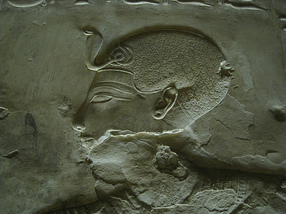 Ear/saragoldsmith It is practically blasphemy not to listen to another. Even so, here is a short-list of communications that are hard for me to hear with the ear of the heart, as Saint Benedict puts it. Preachy advice, budget reports, mixed messages, and lengthy recitals that begin in dialogue but drone on into monologue.
My one-word comeback in all cases used to be “Huh?” But more aware now that I live in a universe where so many things are speaking on so many levels, I’ve decided it is probably unwise to ignore voices, no matter how irksome, because they may bear wisdom.
According to Dr. Rachel Naomi Remen, “Listening creates a holy silence. When you listen generously to people, they can hear the truth in themselves, often for the first time. And in
the silence of listening, you can know yourself in everyone. Eventually you may be able to hear, in everyone and beyond everyone,
the unseen singing softly to itself and to you.” **
In Small Group Ministry, at the San Francisco Unitarian Universalist church, I trained to listen in silence and to encourage new group members to listen the same way. At first I found paying silent attention difficult, for it went against a lifetime of habits I had learned to incorporate as a social being – nod, sigh, “oh” and “ah.” While not tempted to interrupt, I did want to ask questions. And being a “good person,” I would sometimes think I should offer help or advice. Although being a silent listener or being listened to in silence can feel hard, it is worth exploring because “cue-less” listening allows the speaker to go deeply into her own thoughts without watching for cues that her words are winning approval or causing disapproval. As I said, not easy at first, but at the heart of silent listening is trust that one is heard and courage to speak one’s truth.
As a Worship Associate in my church, I gave a four-minute reflection called “Listening with the Third Ear.” Eventually I expanded that talk into a sermon I gave at the Petaluma UU Fellowship. Speaking for more than four minutes allowed me to add more ears and call my talk “Four More Ears.”
My third ear corresponds to “The Third Eye” – the ear of the heart that hears the heartfelt. It’s the third ear in which resonate Paul Tillich’s words: “The first duty of love is to listen.” And these words from David Oxberg: “Being listened to is so close to being loved that most people cannot tell the difference.”
As for the fourth ear, I am not sure all people need it. For me, it’s a cautionary ear because some information may be just that and not a clue to a deep truth. Thus the work of the fourth ear is to redirect information that is just information back to ears one and two.
My fifth ear turns inward and operates in the pause that allows a reaction to become a response. It listens for the sound of childhood pain that once would have been a cry but with language has turned into something else, usually cruel and instant. When I can hear my own pain and identify it as from the past, I can acknowledge it without reacting and continue to fully hear the other person.
My sixth ear is another ear turned inward. It listens for stories I’m telling myself about the other person and prevents speech I might regret later. One of the reasons I try not to listen from story is that I know how it feels to be responded to from the story rather than in that moment. Once, a friend decided that I suffered from low self-esteem. Thus whatever I said, she responded with words of reassurance. Rather than feeling better, I felt irritated, annoyed and alone. We’re no longer friends.
When I think about being fully present with others, all ears operational, I include the clerk at the DMV, the men and women I meet on the streets and, of course those closest to me, the ones it’s often really hard to listen to. Choosing to relate this way means accepting a total person, not picking and choosing aspects that suit me, hoping over time to change the parts I don’t like.
Listening to the whole person becomes a holy act. “Our listening creates sanctuary for
the homeless parts within the other person. That which has been denied,
unloved, devalued by themselves and others. That which is hidden.”**
* “Music makes an altar out of our ears. A single struck tone, a note blown from a flute, can flush the body with goodness.” W. A. Mathieu, Sufi musician in The Musical Life.
** Dr. Rachel Naomi Remen is Clinical Professor of Family and Community Medicine at the UCSF School of Medicine and Director of the innovative UCSF course The Healer's Art, which was recently featured in US News & World Report. She is Founder and Director of the Institute for the Study of Health and Illness, a ten-year-old professional development program for graduate physicians. She is the author of the New York Times bestseller Kitchen Table Wisdom: Stories That Heal. Her newest book, My Grandfather's Blessings: Stories of Strength, Refuge and Belonging is a national bestseller.
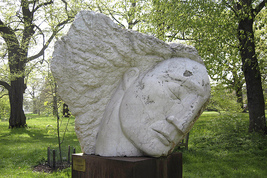 Wounded Angel I / Emily Young 2003 It had been my habit to apply black or brown eyeliner. But since February 2011, eyeliner is no longer part of the face I prepare to meet the faces that I meet, to paraphrase J. Alfred Prufrock.
It’s not newly acquired beauty expertise that has me leaving off the eyeliner. It has more to do with crying, which causes made up eyes to sting and leaves cheeks streaked and smudged.
In the last year there have been special reasons for tears – a son whose wife is suddenly deceased leaving him with a four-year-old daughter, another son leaving his wife to make a connection on the east coast, and my own exit from a long-term relationship. Now add Jennifer, a therapist who encourages not masking past pain; keeping my eyes dry appears impossible.
I wonder if the Buddha wept as he realized that pain is inevitable, but suffering is optional. Stretching to accept such truth, I try to be at peace with present and past pain, through which I can yet become what Rumi calls “a mighty kindness.”
Often I turn to Rumi for truth shaped like a poem. In “Not Here,” in praise of the “broken-open place,” Rumi talks of human woundedness.
There's courage involved if you want to become truth.
There is a broken-open place in a lover.
Where are those qualities of bravery and sharp compassion?
What's the use of old and frozen thought?
I want a howling hurt.
This is not a treasury where gold is stored; this is for copper.
We alchemists look for talent that can heat up and change.
Lukewarm won't do.
Halfhearted holding back, well-enough getting by?
Not here.
Reading Rumi on couragously wanting “a howling hurt,” I heard again my therapist, Jennifer, praise me for being willing to befriend my pain. As a practiced deflector of praise, I was quick to dismiss my sorry tears and suggest that some might say “attending and befriending” myself was narcissistic.
But even before being beset by family tragedies, I had chosen to be in therapy. My plan was a quick fix, an emotional realignment so I could enjoy my girlfriend on a cruise to Mexico. The therapist, however, didn't think I needed fixing, despite how explicit I was about what wasn’t working. So began the crying.
Month followed month, tearful session after tearful session. I re-experienced and identified with feelings about myself that went back to a childhood of disconnection. All so familiar. Meanwhile, the cruise sailed without me.
I cried my way back through a childhood in boarding schools, to painful and scarring accidents, to raging jealousies and competition within the family, and to bouts of mania and depression.
I have read and heard of so many in therapy further demoralized at re-experiencing the sadness they thought they had put behind them. And it’s no great help when waves of shame come as one considers one’s own suffering as inconsequential in the face of other’s childhood tragedies. And yet all the wisdom tells us that the best way out is always through. So on we go, facing pain.
Sometime into the second month of tearful sessions, Jennifer introduced me to John Welwood’s book Perfect Love, Imperfect Relationships and that led to turning inward to feeling my own yearning for love and disconnecting those feelings from any person. This was also a cause for pain because I had no strong memory of having been loved to yearn for. Then my friend Kate found Buddhist teacher and psychotherapist Tara Brach and we listened to podcasts recorded in Bethesda, MD and from this followed a deliberate practice of meditation, with sittings at the Zen Center in San Francisco and at the East Bay Meditation Center, as well as at my own UU church.
Once again I turn to a Rumi poem for truth. From “Childhood Friends:”
"Trust your wound to a teacher's surgery.
Flies collect on a wound. They cover it,
those flies of your self-protecting feelings,
your love for what you think is yours.
Let a Teacher wave away the flies
and put a plaster on the wound.
Don't turn your head. Keep looking
at the bandaged place. That's where
the Light enters you.
And don't believe for a moment
that you're healing yourself."
All my teachers – Jennifer, Tara, Kate, Rumi, the lecturers at meditation practice – hold up mirrors I have feared to look into, afraid to see a face I could not look at with compassion and forgiveness. Now, the light by which I see isn’t my light at all. And it isn’t the light I had expected. And in the light, I look quite all right, even without eyeliner.
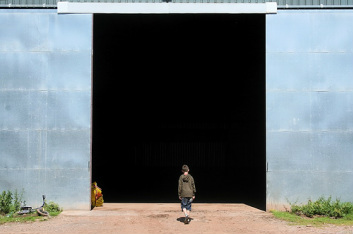 Black Hole / fotologic (Jon Nicholls) Nothing matters more to me now than it used to. When first I proclaimed “NOTHING MATTERS” it was in my newspaper column, “Alison’s Wonderland,” my sophomore year at Occidental College. I went on at some length and attributed my disdain for conventional wisdom to what I’d learned from a cursory reading of Bertrand Russell and existentialists such as Sartre and Heidegger.
Now when I say nothing matters, I’m saying that nothing by which I defined myself in the past needs to limit me today. I am free to explore and create a new narrative unhindered by self-limiting stories.
In The World is Made of Stories, Buddhist David R. Loy talks about a constricting and self-limiting understanding of the self based on the stories we tell about ourselves, over and over. These are the stories we have been telling ourselves and others about who we are and what our world is like. They are the way we understand our own lives. We live in these stories as fish live in water.
Beyond stories that limit our identity is another part of ourselves, a still-unstoried self that “preserves the possibility of novelty, of doing and becoming something different,” Loy says. He calls this un-narrated part of us “No-thing-ness.” Nothingness. Nothing solid. This is the no-thing-ness that matters to me now.
Given this new concept of the nothing that matters, I can skip quickly through the past that no longer need define me. In the late ‘50s, the “nothing” that mattered to a sophomore in a private, Presbyterian liberal arts college where chapel was compulsory was “no school rules matter. But, as I break them, please notice.” I am no longer that morose, skinny, brunette in a black leotard, eager to define herself by her lack of beliefs. Nor am I the young mother of two little boys in her twenties asking god to turn her into a believing Jew, nor the middle-aged woman hoping for a lift through total baptismal immersion and calling herself a Christian. Iteration after iteration brings me to now, a Unitarian Universalist without dogma, as well as a budding meditator for whom the “no-thing-ness” promises a chance to broaden my narrative.
Rumi’s poem “The Worm’s Waking” encourages me to “wake up” and slow down the story telling so as to make room for this broader narrative.
THE WORM'S WAKING
This is how a human being can change:
there’s a worm addicted to eating
grape leaves.
Suddenly he wakes up,
call it grace, whatever, something
wakes him, and he’s no longer
a worm.
He’s the entire vineyard,
and the orchard too, the fruit, the trunks,
a growing wisdom and joy
that doesn’t need
to devour.
Through meditation and learning from Buddhist teachings, I am making space to be cast in new narratives, especially those that allow space for living loving-kindness. Through loving-kindness, I realize how much I have in common with others. Like me, every sentient being wants fulfillment and to escape suffering.
Living loving-kindness means practicing empathy, being willing to see the world from another point of view. It’s wishing others well. It is friendliness, consideration, kindness, and generosity. It is the basis for compassion, for shared joy. It’s my inherent potential. To wish another well is to wish that they be in a state of experiencing loving-kindness. Moreover, it is an attitude rather than just a feeling.
Freeing myself from the fixed and limited “I,” in my habitual stories, I am beginning to give myself space to be a kinder, more loving person. With that intention perhaps I can answer a question David R. Loy poses: “What stories do I want to live? The non-dual way to say this is “What stories want to come to life through me?”
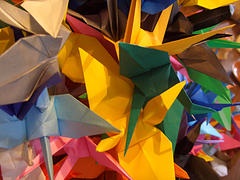 Paper Cranes/Tonx I’m confused about the Buddha’s Eightfold Path. Being unenlightened, I’m uncomfortable confused. If the path is just the path without eight folds, no problem. But the numbers bewilder me. I can’t cope with an eightfold path plus five precepts and four noble truths. Numbers became an issue about the same time I was being admonished to color inside the lines of my first coloring book. It was then that I slipped into conflating numbers and colors. By the time I met school arithmetic, addition and subtraction had become a Technicolor smear. Eight was yellow, five red, four blue and so on. An additional stumbling block on the math path was a remedial high school math teacher whose passion wasn’t us laggards. To coach the tennis team, he was required to teach us math. Though the task filled him with contempt, it was a playful sort of don’t-give-a-damn. This, coupled with our being the last class of the academic day, explained why Mr. Don Hahn stood on his hands and instructed upside down in front of the chalkboard dressed in white tennis shorts and a polo shirt. Clearly, I was too distracted to grasp the complexity of numbers from so near the floor. Now, older and no longer challenged by remedial math classes or staying inside the lines of coloring books, I am fast tracking to enlightenment. I sense an urgency to awaken before karma claims me and I’m back again as a betula pendula*. To hurry the enlightenment process, I enroll in an “Intermediate” Buddhist meditation class after only five months of meditation. And while smart enough to keep up; not so swift when faced with numbers (one eightfold path, five precepts and four noble truths). I had thought my problem with numbers was over but then one of the soft-spoken shikshaks* divides the eightfold path into three and then divides each three into two. My calculations total six. Plus the five red precepts and four blue noble truths and we are up to a muddy brown 15. That’s when frustration causes me to complain that I can’t hear anyone and would everyone please speak louder. In a different meditation session, this one at the Zen Center, I envision solutions to the dilemma of eight folds as I sit, eyes softly downcast, surveying the coming and going of thought as if through a train-station window. Coming in from the left, going out to the right. Suddenly, the folds in the eightfold path appear to my mind’s eye as folds in small sheets of colored paper, the crafting one might find in origami. Fold, fold, fold, into the tiniest of creations: a crane, a horse, a giraffe, an infinitesimal circle of intricate folds. I like this origami image. As I understand it, the Buddha’s eightfold path isn’t meant to take me somewhere other than where I am in any moment. Eventually, I look up the Eightfold Path to Happiness as explained to kids, and I decide to be okay with numbers. In child mind, I imagine learning by rote, the way we did when we learned multiplication tables. This kind of learning keeps colors out of my equations. THE EIGHTFOLD PATH TO HAPPINESS*** 1. Right Views: To keep ourselves free of prejudice and superstition, and to see the true nature of life. 2. Right Thoughts: To turn our minds away from the violence and hatred in this world. 3. Right Speech: To refrain from harmful talk and to use our words wisely. 4. Right Conduct: To see that our deeds come from peace and goodwill. To grow every day in the Buddha's Teachings. 5. Right Livelihood: To try to earn our living in such a way that we avoid evil karma. 6. Right Energy: To use our energies to overcome ignorance and destructive desires. 7. Right Mindfulness: To cherish a good mind, for all that we think and do have their roots in the mind. 8. Right Meditation: To study the Teachings of the Buddha and to practice them to the best of our abilities. And though the Buddha taught more than 2,500 years ago and learning to awaken involves dividing concepts into more numbers than I’m comfortable with, the practice of meditation is reshaping my life, folding me into a lovingness I have never known. Color me peaceful. *Latin for silver birch tree
**Sanskrit for teacher
***From the ManitobaBuddhist Temple
|













 RSS Feed
RSS Feed